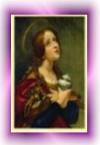His journey of assisting pilgrims and travellers began with the restoration of the Hospice of Campugliano, which was practically in ruins. It was entrusted to his industrious piety. Allucio brought the building back to an admirable Shelter, in which work he was assisted by some comrades, who were rich like himself, in the zeal of charity. These friends formed the core of the Lay Apostalate which was later called Brothers of SaintAllucio.
To better assist the poor and needy, the young Allucio founded another hospice on Monte Albano. He created a third one near the bank of the Arno, over which he even built a bridge, for the convenience of pilgrims. The latter was not an easy ndertaking, not only for the technical problems but because Allucio had to convince and appease the local ferryman, who earned hefty earnings by carrying travellers from one bank to the other.
According to tradition, miracles multiplied in great numbers around the benefactor of the poor. For this reason, real diplomatic missions were delegated to him in distant Cities, which Allucio carried out successfully, managing to pacify them, for example, the two rival Cities of Ravenna and Faenza came at last to peace through his negotiations.
Among the miraculous interventions handed down by devotion, the most unusual was that of the man whose eyes had been gouged out, as punishment for some crime committed, according to the so-called “retaliation law,” common in the Middle Ages. Not out of contempt for justice but out of pity for the blinded, even if guilty, Allucio put his eyes back in the hollow sockets of the condemned, restoring his sight.
He built two Churches, a bridge over the Arno, three Shelters and Hospices for pilgrims and other travellers, including one on his own properties at Campigliano near Uzzano and others in mountain passes and river crossings. He was a generous almsgiver and carer of the sick and the poor. In all this work, the “Brothers of Saint Allucio,” grew in numbers and in their charitable works and became an powerful Apostolate.
As active as he was in doing good, he was equally strict with himself. He never ate meat, nor cheese, nor eggs. He fasted three times a week. And for seven consecutive Lents, he touched no food at all.
He died at Valdinievole on 23 October 1134 calm and active until the last moment. He was immediately made the subject of a lively popular cult.
His body was interred by the Brothers in the Church of Saint Luke in Campugliano. In 1344, his relics were enshrined in a stone urn at the High Altar of the Cathdral of Campugliano by Dominican Brother Paul Lapi by order of Bishop Guglielmo Dulcini of Lucca, Italy. In 1792, the relics were moved to the Chapel of Our Lady of the Rosary, Cathedral of Pescia and finally, in 1934, they were moved to the new Chapel built in his honour and dedicated to Saint Allucio in Campugliano.
He was Canonised on 23 October 1182 by the Bishop of Lucca, Italy on behalf of the Pope.
When Allucio’s relics were being translated in 1344, a Vita was discovered stored in the reliquary., which contained a record of the many miracles granted at the intercession of the Saint.

